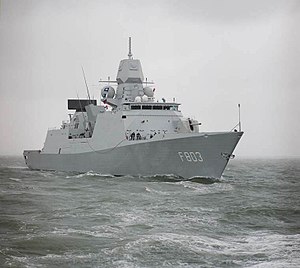De Zeven Provinciën-class frigate

|
|
| Class overview | |
|---|---|
| Name: | De Zeven Provinciën class |
| Builders: | Royal Schelde, Vlissingen |
| Operators: |
|
| Preceded by: | Tromp class |
| Cost: | €600 million ($816 million) |
| In commission: | 26 April 2002 – present |
| Completed: | 4 |
| Active: | 4 |
| General characteristics | |
| Type: | Air-defense and command frigate |
| Displacement: | 6,050 tonnes (full load) |
| Length: | 144.24 m (473.2 ft) |
| Beam: | 18.80 m (61.7 ft) |
| Draught: | 5.18 m (17.0 ft) |
| Propulsion: |
|
| Speed: | 30 knots (56 km/h; 35 mph) |
| Range: | 4,000 nmi (7,400 km; 4,600 mi) at 18 knots (33 km/h; 21 mph) |
| Complement: | 30 officers, 202 ratings |
| Sensors and processing systems: |
|
| Electronic warfare & decoys: |
|
| Armament: |
|
| Aircraft carried: | 1 × NH-90 helicopter |
| Aviation facilities: | Hangar and flight deck for 1 medium sized helicopter |
De Zeven Provinciën-class frigates are highly advanced air-defence and command frigates in service with the Koninklijke Marine (Royal Netherlands Navy). This class of ships is also known as LCF (Luchtverdedigings- en commandofregat, air defense and command frigate). The ships are similar to the German Sachsen-class frigates in role and mission. During international exercises performance of the sensor suite and weapons platform have been proven to be exceptional and 'best in class'. It should be noted that the classification of these ships as frigates is subject to debate given that due to their capabilities, these ships would in other navies be classified as destroyers.
These ships were optimized for the anti-air warfare role. For this role the ships are equipped with an advanced sensor and weapons suite. The primary sensors for this role are the long range surveillance radar SMART-L and the multi-function radar APAR. The SMART-L and APAR are highly complementary, in the sense that SMART-L is a D band radar providing very long range surveillance while APAR is an I band radar providing precise target tracking, a highly capable horizon search capability, and missile guidance using the Interrupted Continuous Wave Illumination (ICWI) technique, thus allowing guidance of 32 semi-active radar homing missiles in flight simultaneously, including 16 in the terminal guidance phase. The primary anti-air weapons are the point defence Evolved Sea Sparrow Missile and the area defence SM-2 Block IIIA. The Mk 41 Vertical Launch System is used to house and launch these missiles. 32 Evolved Sea Sparrow Missile and 32 SM-2 Block IIIA are carried.
The Koninklijke Marine is investigating the use of these ships for the role of Ballistic Missile Defence (BMD). During tests carried out by HNLMS Tromp in the Pacific ocean near Hawaii, experimental modifications to the SMART-L to allow even longer range were proven. A study by the Koninklijke Marine, the Netherlands Defence Material Organization, Thales Nederland, Raytheon Missile Systems, Johns Hopkins University Applied Physics Laboratory, and Lockheed Martin has been conducted to establish the feasibility of modifying the De Zeven Provinciën class to provide it the capability to intercept ballistic missiles. In particular, the study examined the feasibility of integrating the SM-3 Block IB missile with the SMART-L and APAR radars. The study concluded that – with certain modifications to the SMART-L and APAR, as well as to the ship's Combat Management System and the missile itself – BMD with the De Zeven Provinciën class could be achieved. During a 2015 very large NATO exercise the BMD capabilities were proven, the sensor suite discovered Ballistic targets and destroyed them using both own SAM missiles as well as using a US Destroyer's SAM weapons, providing target data and missile guidance.
...
Wikipedia
